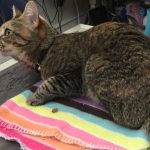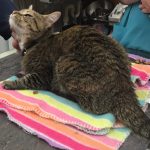Tut-Tuts and Top Tips for Laser /PBMT Treatment of our Feline Patients.
One of the biggest misconceptions out there is that cats won’t tolerate Laser therapy. Contrary to what you may have been told, Cats will tolerate Laser therapy but on their terms.
So, to help colleagues abide by those feline terms, I have put together a six-point treatment checklist for Vets to be aware of before they start any Laser treatment on any cat.
PBMT/Class 4 Laser: The Seavers Six “ions” for Feline Laser Therapy
- Preparation
You must adjust the treatment room to allow the cat to first settle i.e., the CDFH rules of cat consultations.
If you have a cat-friendly practice-chose the calmest area to park your Laser machine. Play Calming music in a Darkened room with the Heat and the Feliway pumping.
- Use the knowledge that Cats have an absolute,1,2 requirement for heat with a preference for areas with an ambient temperature of >32C to your treatment advantage.
In our clinic, we used warm heated covered beds on our tables for all our cat patients, regardless of presentation, so Laser therapy patients should not be treated any differently. These small beds were strictly cat-use only to avoid any contamination from stressful dog pheromones, plus the removable fleece covers were quick & easy to wash and rotate. Have the heated beds also sprayed with Feliway & catnip and even nervous cats will learn to settle. The nervous cat in the 3 images below went from panicked to smooching in a very short space of time once he was allowed to have a moment to acclimatise to his surroundings and settle on the warmed pheromone-rich mini heated bed on the consult table. Sensory-Sympathetic Coupling translates as emotional arousal worsening pain, so the more anxious the cat the worse its pain. Stress enables an amplification of pain so set your laser session up for success by first reducing known stress triggers in your treatment arena.



- Once the cat has settled, either Zoom Groom or massage the cat on a body site well away from the presenting treatment site.
- If this is a chronic case being treated for the first time am recommending starting with a puff of air, breeze, or feather test on the injured area to flush out if allodynia is an undiagnosed major concern for this cat. If no aberrant response to the airflow past test-then put the pet goggles on the cat.
- Goggles.
Most cats are not bothered by the Goggles. Some cats are really calmed down by having the goggles on. However, on the rare occasion that a cat does not tolerate the goggles, use the principles of the calming ‘burrito’ wrap to cover the cat’s head in a heavy black cloth and tuck the head and neck gently back in under the owner or assistant’s arm. For more information on alternatives to goggles to assist in blocking laser light, please read our safety proforma on Ocular Safety in your V1l client OneDrive file.
Only after you have addressed the issue of patient eye safety, do you now apply the Laser to the affected area.
During the Laser application time, depending on the cat’s temperament and the treatment lesion location, you can additionally distract the cat with a treat lick mat or food toy.
2) Program Selection.
For cats- the duration of the treatment session has to be short.
The old Veterinary Maxim that most cats will give Vets 3 minutes max stationary before objecting, means you need to be using Veterinary Laser machines with abilities to do a full treatment program in under 5 minutes. Nowadays that is easy to achieve as many of our pre-set programs average running over a 1-2-minute session. The 5-minute Class 4 treatment sessions tend to be reserved for really large lesions or areas; wherein the cat either has had some sedation to be handled or is just not inclined to want to move around anyway, so more cooperative in general.
3) Application
Again, here the Laser rules of a dynamic 360 circumferential grid application have to be tempered by the species treated.
Initially, we are happy to just cover as much of the damaged area as possible without the need to move the affected limb through its range of motion. Rather, we move around the area or adjust the cat bed, but try to leave the cat with minimal handling.
The aim is always to try and cover regional lymphatics, trigger points, nerve tracts to the area, and upstream and downstream anatomical secondary and tertiary victims of the initial primary injury. Often this ideal is not possible on any patient in the first couple of sessions, so consider targeting those areas as the primary lesion becomes less painful. Conversely, with all things feline-sometimes it’s the upstream major nerve tracts entering the injured area and or the draining lymphatics or supporting connective tissue outside the area that the cat will initially only allow to be treated.
3a) Contact; Easy goes it!
Even if the head of the handpiece of your particular machine needs to be in contact with the cat-that doesn’t mean you have to need to dent the poor cat! Everyone has an individual tolerance level not only to pain but also to pressure. I have seen videos of heavy-handed veterinary operators using a contact head and they look like they are ploughing a field, not applying a therapeutic modality to a living body part so no wonder the vet patient objects. There are many levels of massage intensity but very few veterinary patients should be subjected to the higher level, painful massage techniques as the vet patient is not an equal player in the massage therapy as the human patient is.
A lot can be done with the lightest of touches so go easy and go gently, especially on the first few outpatient visits.
If the cat will not tolerate any touching of the area at all in the acute presentation: go off-contact for the first couple of sessions until the primary lesion is less painful. There are now several veterinary machines out there that have both on and off-contact heads.
For my laser vet users, I teach the S.O.Y..Rule to know when to select the Off-contact method.
The cat might allow you to do on-contact for the 2ndary & tertiary areas or on the intervertebral area and exiting nerve that supplies the diseased areas.
In the chronic presentation, wherein the cat is not tolerating the Laser, the lesions themselves can have undetected allodynia in full swing. These allodynia patients will have a truly adverse intolerable response to any applied pressure and even initially to off-contact treatment.
4) Repetition
The feline treatment regime, unlike dogs-should, perhaps not be done daily but rather wait and repeat after a recovery phase of 48-72 hours.
Why are we recommending this longer gap, when the textbooks say cats can have daily Laser therapy sessions?
We currently recommend this 48–72-hour gap for a myriad of reasons:
- Cats are very vulnerable to stress in general, from oxidative stress to behavioral stress.
Users of older Laser model machines had concerns that daily use put the cat in an oxidative stress zone and so they recommended a 48-hour frequency.
- With allodynia cases, a percentage end up having a bad day following the initial session but over 48 hours will begin to really benefit with dramatic drops in neuropathy. By that stage, you have a much less uncooperative patient than if you rushed the cat back in 24 hours later whilst it was still in the post-treatment storm. The rebound storm issue, though rare, appears to occur on the first treatment of a chronic case-not in subsequent sessions, hence why important to pace and space where you can.
- Behaviour Specialists talk of it taking a cat up to 72 hours to recover from the stress triggered by any Vet visit, which leads us to owner Behaviour.
- Cat Owner compliance every 24-48 hours is poor.
This owner’s reluctance is due in no small part to their cat still recovering from the previous Vet visit. This lag phase to normalcy very quickly stops the owner from representing the cat for regular daily or every other day treatment session.
- Historically, 72 hours seems to be the feline drug therapy ‘sweet zone’…
You can decrease the gap to 12-48 hours in Acute presentations, where if you either feel the lack of response or the degree of disease/injury presented is such as to merit an initially higher level of intervention.
In those ill cats, most are admitted to hospital wherein attention to the provision of supportive therapies, biochemistry screen trends & antioxidant medication is the norm and so lessens any concerns in general.
- After two weeks, move out to once weekly then fortnightly, etc., or as your individual patient’s needs dictate.
Currently, in the absence of sufficient peer-reviewed studies on cats to absolutely state 24hr-48hr frequency gaps, we are erring on the side of caution and advising routine treatments have a 48-72-hour gap. Over time, as peer data flows in more and more, we may change this recommendation, but currently, Primum Non-Nocera has to be the first rule of any therapy consideration.
5) Sedation
If you are using the Laser on any sedated pet-and hence a patient who cannot actively remove itself from the treatment field- and especially if you sedated this cat to shave/ clip it-then always use a trailing finger to monitor the treatment intensity.
6) Clipping Fur Question
Q: Do you still need to clip the pet’s fur before Laser therapy?
A: No, you don’t routinely need to shave the pet.
Once upon a time, shaving was needed but no more. The evolution of modern Class 4 Laser machines with in-built protocols factoring in colour, coat, body size, etc. to pre-select the correct parameters for delivery and wavelength to maximise absorption by the target tissue means most pets no longer need to be shaved pre laser therapy.
You can still shave if the hair is overly long and matted or filthy.
Not needing to shave a cat greatly increases owner compliance and reduces Veterinary staff stress considerably.
Summary
No need to shave unless doing laser acupuncture.
Provide a calm safe zone,
Check for allodynia,
Allow the cat to settle,
Select powerful fast sessions and
Space the return visits frequency.
Check out this excellent cat laser video from the incredible team at Waterwalkies.
https://www.facebook.com/reel/1118128003396725
Conclusion.
We hope the above is of help to all Veterinary Laser users.
At Vets1Laser, we are passionate about putting Veterinarians at the forefront of Laser /PBM therapy.
If you have any different experiences using Laser in cats, we would love to hear from you.
Contact Dr Aine at [email protected] to share and discuss any thoughts or knowledge on all things Laser.
READING, LIST.
- Steering the multipotent mesenchymal cells towards an anti-inflammatory and osteogenic bias via Photobiomodulation therapy: How to kill two birds with one stone. Amaroli et al. 2022. Journal of Tissue Engineering; 13: 1–17 DOI: 10.1177/20417314221110192
- The nuts and bolts of low-level laser (light) therapy Hoon Chung et al 2012 Ann Biomed Eng ; (2):516-33. doi: 10.1007/s10439-011-0454-7. PMCID: PMC3288797 DOI: 10.1007/s10439-011-0454-7
- Using Warm tables to ‘Chill’ cats and prevent Actinic skin disease. A Seavers. Control & Therapy CVE Sydney Uni. No: 5733 March 2018
- Sun-drunk Cats. Control & Therapy. CVE Sydney Uni No:5639. September 2017: Why do Cats endanger their lives in search of warmth?
- Zoom Grooms. Control & Therapy CVE Sydney Uni: Dec 2007
Views: 14
